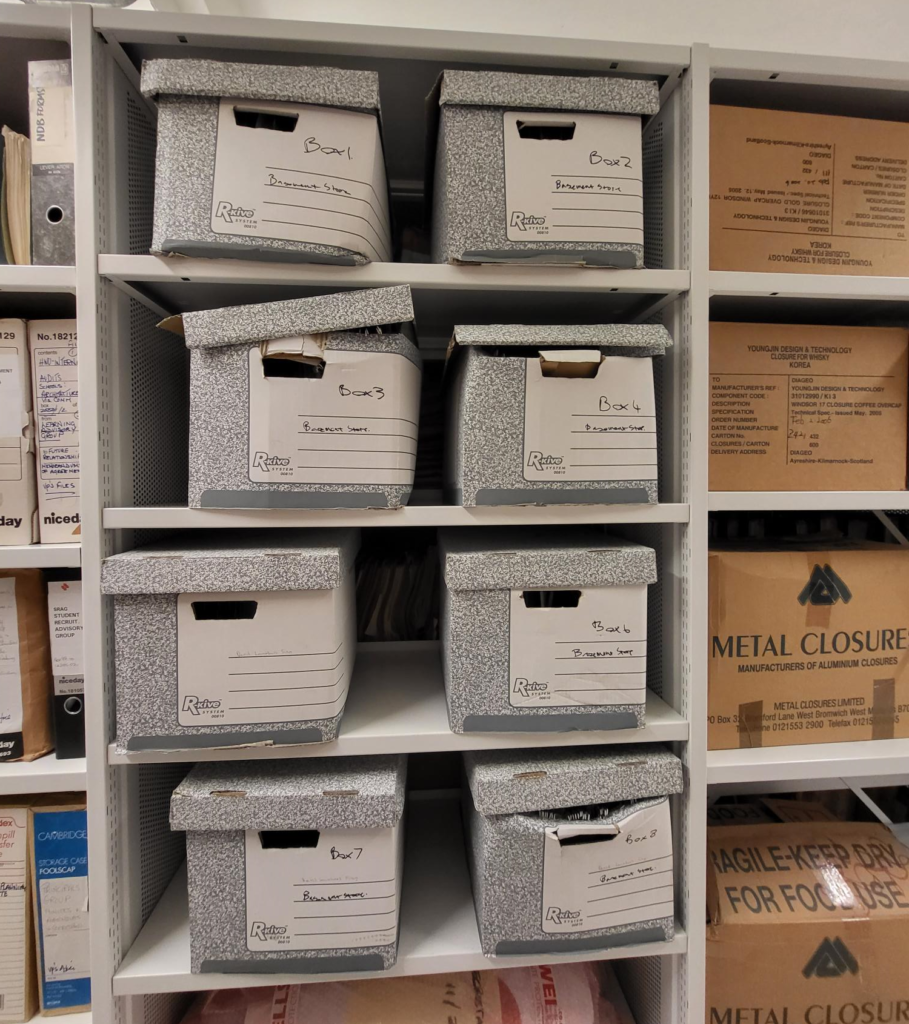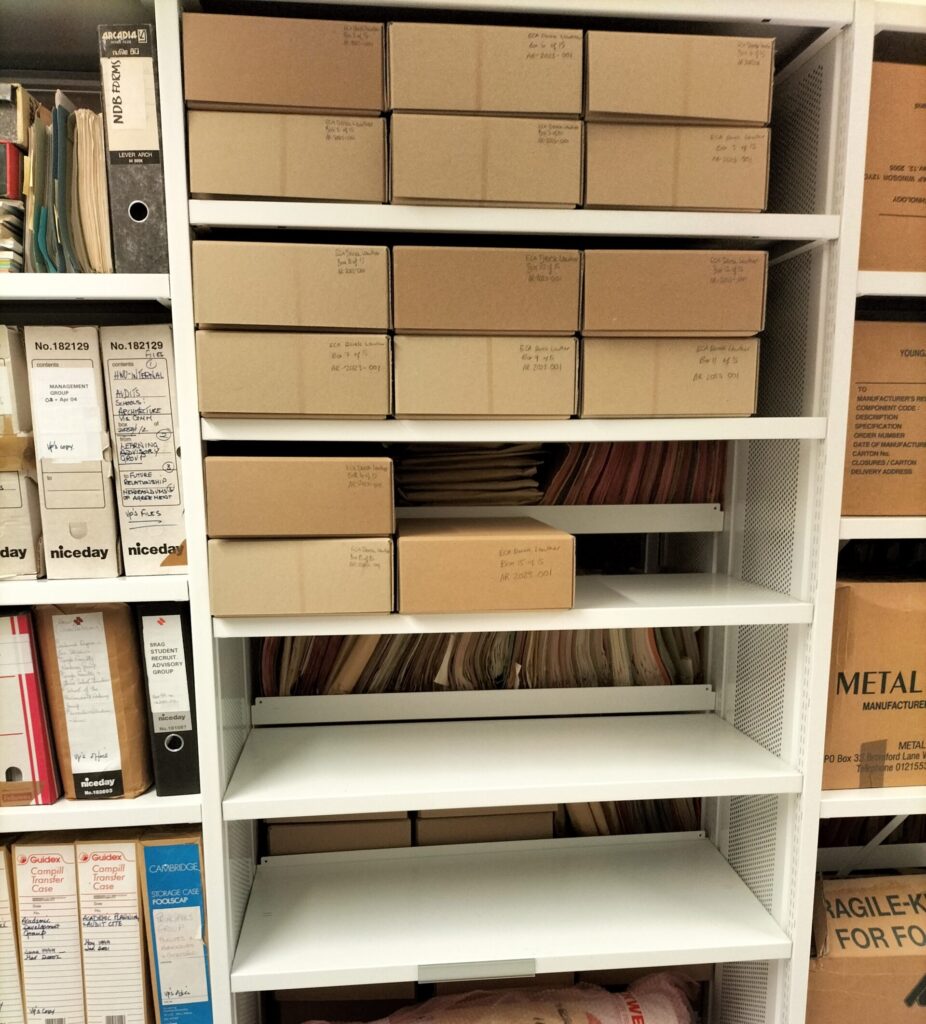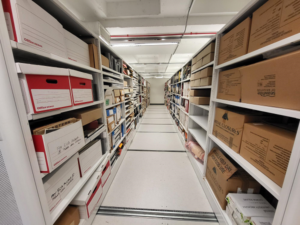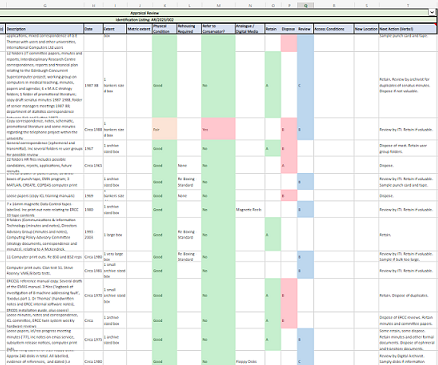Welcome to our Day in the Life Series, where each of our new team members will give you an insight into life behind the scenes at the University of Edinburgh’s Centre for Research Collections. In this post, our new Appraisal Archivist and Archive Collections Manager, Abigail Hartley, discusses what she has been up to since joining the Heritage Collections team in March. Expect one more post in this series, as we introduce our Collection Management Technician, Jasmine Hide.
You may have seen the other week my colleague Robyn upload a new blog regarding her role as Collections Care Technician. If you haven’t… Go go go! Take a look at the fantastic work she has undertaken thus far. Once you have returned, it is my turn to introduce myself and the work I’ll be tackling for the foreseeable future.
Let’s start from the beginning, shall we? My name is Abbie and I have been working at the University of Edinburgh as its Appraisal Archivist since April 2023. These past three months I have been creating an appraisal process and enacting some practice runs on smaller collections in preparation of being let loose amongst the backlog of records held at the assorted Heritage Collections sites across campus.
But what even is appraisal?

During a practice run of testing out a new appraisal process, Jasmine and I were able to get some Edinburgh College of Art papers looking like this…
Appraisal in an archival context is the determining of how valuable a record is to the archive. If it is deemed valuable, then it is placed in the storerooms for permanent retention, ready to be catalogued and made accessible to the public. No two archives are identical, and each has a slightly different focus on what they want to keep. There are some standardised rules no matter the institution – usually you do not need to keep three copies of the same document, signed committee minutes are almost always going to be kept, and a record which is so mouldy that conservation deems it unsalvageable is sadly not going to be retained – but oftentimes, answering the question of is this record valuable? Leads down some almighty rabbit holes.
After all, ‘valuable’ to whom? Who decides what is valuable? How fixed is that definition? These are questions I must carefully consider when creating the criteria for retention.

…to this! We weeded out duplicates and superfluous documentation, as well as followed retention schedules and guidance laid out by legislation such as GDPR and the FOI Act. Re-boxing and re-pitching the shelves created additional metres of space.
What do we mean by valuable anyway? It is not a case of its monetary value (though this may play a role). More frequently, its value is determined by two factors: Does it have evidentiary value, and does it have informational value? In our case, these must relate directly back to the University. Decisions are made based on the records’ provenance, their content, their authenticity and reliability, their order and completeness, their condition and costs to preserve them, and their intrinsic value. Legal requirements through GDPR (General Data Protection Regulations) and FOI (Freedom of Information Act) can also impact retention decisions.
This means we want to keep records which give a clear picture of the operations, administration and major decisions which shaped the University into what it is today. We also want to keep records which will be of interest to researchers, whether they be genealogists, students, or academics, as well as material that will be used for teaching within the courses offered by the University. We do have guidance on these factors and standards to help us make decisions, but these can be improved and made more specific to the types of collections we wish to hold.
One thing we absolutely do not want to be is arbitrary in our decision making. Can we standardise the act of removing the unnecessary material to create tighter and more easily navigable collections before they even make it to the cataloguing stage? That’s my job to figure out.
With over eight miles of shelving and five hundred years of history, the Heritage Collections of the University of Edinburgh are both immense in scale and immense in workload. Organisations like these tend to create a lot of paperwork, far more than any archivist can keep on top of. Thus, a backlog begins, and physical space becomes a premium commodity. At times, it truly can feel overwhelming; a mountain with no visible summit.

With those initial boxes complete, we now move on to the collection as a whole. It spans four and a half rows, so there is much work to be done!
I am going to be working closely with my colleague Jasmine Hide (look out for her blog next month) in a never-ending saga to consolidate and create space within our strongrooms for new incoming accessions, as well as to review existing uncatalogued collections which maybe need a little TLC, and finally make the backlog just a little less overwhelming for our colleagues. By creating lists detailing what we hold and what the final decisions are to be regarding its retention, we aim to increase the findability of these uncatalogued collections, ensure the decision process is well recorded and accountable, flag records in danger for our conservation colleagues, and having the general satisfaction of clearing space.
Yes, this does involve spreadsheets. Many a spreadsheet.

Section of a spreadsheet listing contents, physical condition, and retention or disposal decisions for the Information Technology Institute at the University.
My next steps are to create a list of priorities for collections that need the most attention, formerly establish a workflow to slot the work of appraisal into the broader acquisitioning, accessioning, conserving and cataloguing processes, and of course, actually do the appraising.
We’ll be keeping you up to date with major projects we undertake, with some classic before and after images, so do watch this space for future updates!

Pingback: CRC: A Space Odyssey – Day in the Life of a Collections Management Technician | Preservation Perspectives